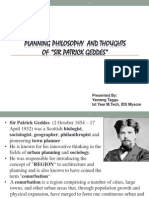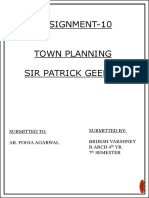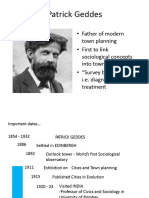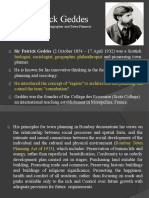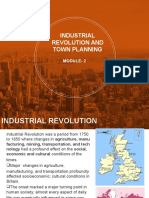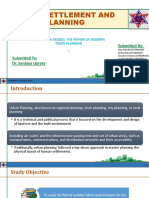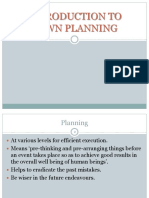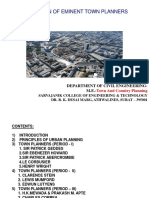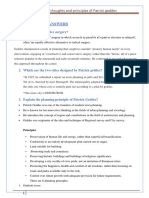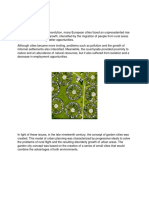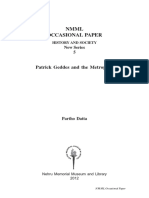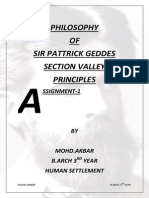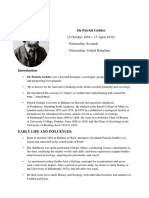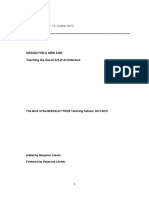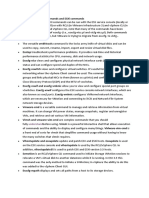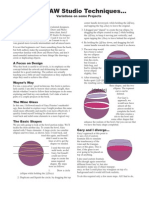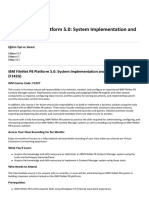100%(1)100% found this document useful (1 vote)
393 viewsPatrick Geddes
Patrick Geddes
Uploaded by
snehanaharPatrick Geddes was a pioneering Scottish town planner in the late 19th/early 20th century. He is known for introducing concepts like "region" and "conurbation" to urban planning. Geddes believed planners should thoroughly understand the unique attributes of the places they are planning for through regional surveys. He saw cities as living organisms that evolve over time through growth and change. Geddes' ideas influenced urban planning around the world and his concepts like conservative surgery, public participation, and understanding the relationship between environment and human activities still influence city planning today.
Copyright:
© All Rights Reserved
Available Formats
Download as PPTX, PDF, TXT or read online from Scribd
Patrick Geddes
Patrick Geddes
Uploaded by
snehanahar100%(1)100% found this document useful (1 vote)
393 views18 pagesPatrick Geddes was a pioneering Scottish town planner in the late 19th/early 20th century. He is known for introducing concepts like "region" and "conurbation" to urban planning. Geddes believed planners should thoroughly understand the unique attributes of the places they are planning for through regional surveys. He saw cities as living organisms that evolve over time through growth and change. Geddes' ideas influenced urban planning around the world and his concepts like conservative surgery, public participation, and understanding the relationship between environment and human activities still influence city planning today.
Original Description:
rough of patrick geddes and his works
Copyright
© © All Rights Reserved
Available Formats
PPTX, PDF, TXT or read online from Scribd
Share this document
Did you find this document useful?
Is this content inappropriate?
Patrick Geddes was a pioneering Scottish town planner in the late 19th/early 20th century. He is known for introducing concepts like "region" and "conurbation" to urban planning. Geddes believed planners should thoroughly understand the unique attributes of the places they are planning for through regional surveys. He saw cities as living organisms that evolve over time through growth and change. Geddes' ideas influenced urban planning around the world and his concepts like conservative surgery, public participation, and understanding the relationship between environment and human activities still influence city planning today.
Copyright:
© All Rights Reserved
Available Formats
Download as PPTX, PDF, TXT or read online from Scribd
Download as pptx, pdf, or txt
100%(1)100% found this document useful (1 vote)
393 views18 pagesPatrick Geddes
Patrick Geddes
Uploaded by
snehanaharPatrick Geddes was a pioneering Scottish town planner in the late 19th/early 20th century. He is known for introducing concepts like "region" and "conurbation" to urban planning. Geddes believed planners should thoroughly understand the unique attributes of the places they are planning for through regional surveys. He saw cities as living organisms that evolve over time through growth and change. Geddes' ideas influenced urban planning around the world and his concepts like conservative surgery, public participation, and understanding the relationship between environment and human activities still influence city planning today.
Copyright:
© All Rights Reserved
Available Formats
Download as PPTX, PDF, TXT or read online from Scribd
Download as pptx, pdf, or txt
You are on page 1of 18
Patrick Geddes
-Introduction , works , contribution to planning
Done by ,
Samiksha ,Sneha ,Puvizhi,Oviya,Naailah
Who Was Patrick Geddes?
Patrick Geddes was a Scottish biologist, biologist, sociologist,
geographer, philanthropist and pioneering town planner .
known also for his innovative thinking in the fields of urban planning
and education.
He was responsible for introducing the concept of "region" to
architecture and planning and is also known to have coined the term
conurbation.
He was also known as father of master town planning
First link to sociological concepts into town planning
Geddes believed planners should have a strong grounding in, and
work with, the unique attributes of the places they were planning for,
which came to be expressed in his motto, Survey Before Plan.
Who Was Patrick Geddes?
A conurbation is a region comprising a number of cities, large
towns, and other urban areas that, through population growth and
physical expansion, have merged to form one continuous urban and
industrially developed area. A conurbation can be confused with a
metropolitan area. A metropolitan area consist of a central city and
its suburbs, while a conurbation consists of adjacent metropolitan
areas that are connected with one another by urbanization.
While he thought of himself primarily as a sociologist, it was his
commitment to close social observation and ability to turn these into
practical solutions for city design and improvement that earned
him a "revered place amongst the founding fathers of the
British town planning movement
He believed in socio-evolution: Societies with "universal Education
which would improve their surroundings; these would upgrade
society, which would then improve the surroundings, and so on.
Who Was Patrick Geddes?
While he thought of himself primarily as a sociologist, it was his
commitment to close social observation and ability to turn these into
practical solutions for city design and improvement that earned him
a "revered place amongst the founding fathers of the British
town planning movement
Patrick Geddes, who was highly influenced by earlier theorists such
as Herbert Spencer and Frederic Le Play, expanded upon earlier
theoretical developments that lead to the concept of regional
planning.
Geddes Timeline
His Influences
Geddes' ideas had worldwide circulation: his most famous admirer
was the American urban theorist lewis mumford who claimed that
"Geddes was a global thinker in practice, a whole generation or
more before the Western democracies fought a global war".
Geddes also influenced several British urban planners, the Indian
social scientist Radhakama Mukerjee and the Catalan architect
Cebria de montoliu (18731923) as well as many other 20th
century thinkers.
Geddes' work on regional surveys, cultural evolution, and urban
sociology has become even more noticed since his death
His Outlook Tower and view on life serves as a catalyst for today's
sustainable city movement.
His Influences
Geddes great achievement has been the making of a bridge
between Biology and Social Science, wrote his biographer Lewis
Mumford
He saw the city as a series of common interlocking patterns, an
inseparably interwoven structure, like to a flower. He criticized the
tendency of modern scientific thinking to specialization. In his Report to
the H.H. the Maharaja of Kapurthala in 1917 he wrote:
Each of the various specialists remains too closely concentrated
upon his single specialism, too little awake to those of the others.
Each sees clearly and seizes firmly upon one petal of the six-lobed
flower of life and tears it apart from the whole.
The master plan of Tel Aviv (Israel) :
Geddes planned the city in 1925 so
that it would answer its residents
spiritual and material needs by
taking into account factors ranging
from climate and social structure to
income.
He believed in fostering human
interaction by bringing people
together naturally in public places,
such as squares, parks and streets;
he did not believe in separating the
commercial centre from the
residential areas else the former
become ghost town during non-
working hours.
Residential buildings were to be low
rise, airy, aesthetically pleasing and
inexpensive.
The master plan of Tel Aviv (Israel) :
Tel Aviv is now frequently referred to as a Living Museum of
Modern Architecture.
UNESCO designed Tel Aviv (White city) as a world heritage site
in 2003.
It is Israel's 2
nd
largest city (after Jerusalem) and the countrys
business and cultural center.
At present Traffic congestion is the main problem of this city.
Works in India
Between 1915 and 1919 Geddes wrote a series of "exhaustive town
planning reports" on at least eighteen Indian cities, a selection of
which has been collected together in Jacqueline Tyrwhitts Patrick
Geddes in India (1947)
He held a position in Sociology and Civics at Bombay University
from 1919 to 1925.
His principles for town planning in Bombay demonstrate his views on
the relationship between social processes and spatial form. They
included: ("What town planning means under the Bombay Town
Planning Act of 1915")
Preservation of human life and energy, rather than superficial
beautification.
Conformity to an orderly development plan carried out in stages.
Purchasing land suitable for building.
Promoting trade and commerce.
Works in India
Preserving historic buildings and buildings of religious significance.
Developing a city worthy of civic pride, not an imitation of European
cities.
Promoting the happiness, health and comfort of all residents, rather
than focusing on roads and parks available only to the rich.
Control over future growth with adequate provision for future
requirements
Patrick Geddes-understanding of cities
-Patrick Geddes understanding of cities is very deep than many of his
contemporaries.
-He was very anxious to draw a plan for solving the problems.
-His firm belief is that the city as a living organism always evolves.
-Its growth and decay are natural.
Patrick Geddes Planning concepts
-Rural development, Urban Planning and City Design are not the same
and adopting a common planning process is disastrous.
-Conurbation -waves of population inflow to large cities followed by
overcrowding and slum formation, and then the wave of backflow the
whole process resulting in amorphous sprawl, waste, and unnecessary
obsolescence.
-The sequence of planning is to be:
-Regional survey
-Rural development
-Town planning
-City design
-These are to be kept constantly up to-date
-He gave his expert advice for the
improvement of about 18 major towns in
India.
Patrick Geddes Regional survey
-In this survey he tried to develop new ways of observing and analyzing
cities.
-It involved collection of all known data of a city and its region such as its
origin, geography , climate, traditions and present socio economic
structure.
-It formed a storehouse of information and helped in preparing a long term
practical strategy for social development.
-He was the first one to create the idea of region in city planning.
VALLEY SECTION
Patrick Geddes Valley Section
In his valley section he clearly showed the relationship between of folk , place
and work.
folk space Work
-He believed that an urban planner should be a generalist than specialist
knowing fairly well about all disciplines.
-In his Valley section he showed that all the natures ocupations have a
place.
-Starting from the head of the valley section the hunter and miner , the
woodman , the shepherd , the poor and rich peasant and the fisherman have
works which are closely related to their surroundings.
-The geographical space shapes the folk and the work, and the people with
their work shape the environment. Thus there is a continuous struggle
between environment and society.
Patrick Geddes Valley Section
Miner
Woodmen
Hunter
Shepherds
Poor peasants
Rich peasants
Fishermen
At the head of the valley section , first activity can be
hunting , until woodman and miner comes in .Next to
forestland comes the pasturages and its shepherds. Next
on the higher and poor soils comes the struggling peasant
followed by rich peasant on the deeper rich land down the
valley. In the end we have the fishermen near sea.
-This is the evolution of human civilization in the valley
section.
-Understanding regions past history and present conditions
help for better socio- economic and cultural organization.
source: Team 10 Primer, MIT Press second
edition 1974 (first edition 1968)
THE DOORN MANIFESTO
Patrick Geddes
-There are always problems in the cities which need immediate attention such as
growing slums , increasing traffic , urban renewal etc.
- To deal with these he developed a technique called Conservative surgery.
-Congestion is always high at
intersections.
-He wanted to create smooth
traffic flows by pulling down
carefully selected houses which
are old.
- Public participation is another
important concept that he
stressed.
On the left, you can see the colonial government's plan for wiping out most of this
residential neighborhood in order to improve its housing and reform its street plan into
a 'modern' grid (overlaid on map). Geddes showed how the government's objectives
could be achieved with far less time and money by careful attention to detaila close
look at the actual situation on the street.
The little illustration above
shows one of his proposals
You might also like
- CONTRACT NO.: GC20105600 / 4299: Contract Title: Epic For New Gasoline and Jet Storage Facilities in MicDocument45 pagesCONTRACT NO.: GC20105600 / 4299: Contract Title: Epic For New Gasoline and Jet Storage Facilities in MicpradeeshNo ratings yet
- Patrick GeddesDocument5 pagesPatrick Geddesamika goyalNo ratings yet
- Ddesian TriadDocument2 pagesDdesian TriadPragnyaraj BisoyiNo ratings yet
- The SeersDocument3 pagesThe SeersAntoinette Repotente0% (1)
- Meyerhof Method PDFDocument3 pagesMeyerhof Method PDFTee Bun Pin50% (2)
- Patrick GeddesDocument19 pagesPatrick GeddesYamang Taggu100% (2)
- Patrick Geddes07Document48 pagesPatrick Geddes07Saurabh SumanNo ratings yet
- K. Bhavatarini C. Elakkiya V. Gayathri A. Noor Afrin D. PonkaviDocument25 pagesK. Bhavatarini C. Elakkiya V. Gayathri A. Noor Afrin D. PonkaviTushar GorleNo ratings yet
- Urban DesignDocument42 pagesUrban DesignDamanpreet Dandiwal0% (1)
- Patrick GeddesDocument10 pagesPatrick GeddesmehalshahNo ratings yet
- Assignment Print-Pettick GeddesDocument9 pagesAssignment Print-Pettick Geddeslavanya thangavelNo ratings yet
- Patrick Geddes r4Document9 pagesPatrick Geddes r4M Pradeep KumarNo ratings yet
- Patrick Geddes Urban PlannerDocument7 pagesPatrick Geddes Urban PlannerpuneetNo ratings yet
- Socio-Economic Base For PlanningDocument10 pagesSocio-Economic Base For PlanningTushar GorleNo ratings yet
- Patrick Geddes Town Planning PresentationDocument24 pagesPatrick Geddes Town Planning Presentationgau100% (2)
- Sir Patrick Geddes Theory of Settlement PlanningDocument24 pagesSir Patrick Geddes Theory of Settlement Planningspunky16788No ratings yet
- Patrick Geddes - Sanan VermaDocument22 pagesPatrick Geddes - Sanan VermaKhalida ParveenNo ratings yet
- Patrick GeddesDocument10 pagesPatrick Geddeskritish duaNo ratings yet
- Patrick GeddesDocument13 pagesPatrick GeddesShívã Dúrgèsh SDNo ratings yet
- Presented By:: (Biologist, Sociologist, Geographer and Town Planner)Document24 pagesPresented By:: (Biologist, Sociologist, Geographer and Town Planner)ShubhaNo ratings yet
- CMP 3Document45 pagesCMP 3Dhruvaditya Jain0% (1)
- Sir Patrick Geddes and Theories PDFDocument18 pagesSir Patrick Geddes and Theories PDFAnshul Chaudhary100% (1)
- Industrial Revolution and Town PlanningDocument24 pagesIndustrial Revolution and Town PlanningAnupamaTirkey33% (3)
- Garden Cities To The WorldDocument18 pagesGarden Cities To The Worldjulia.caixetaNo ratings yet
- Howard ResourseDocument12 pagesHoward Resoursefitsum tesfayeNo ratings yet
- Patrick GedesDocument2 pagesPatrick GedesJames MbuiNo ratings yet
- Patrick Geddes: Father of Modern Town PlanningDocument20 pagesPatrick Geddes: Father of Modern Town Planningloveena100% (2)
- Urban Planning-Patrick GeddesDocument18 pagesUrban Planning-Patrick GeddesANUSHA TIMILSINANo ratings yet
- Patrik GeddesDocument10 pagesPatrik GeddesGopika Nair VGNo ratings yet
- Theories and Ideas That Have/are Changing CitiesDocument87 pagesTheories and Ideas That Have/are Changing CitiesNishant SharmaNo ratings yet
- Module2 Urbanplanningtheories-1Document52 pagesModule2 Urbanplanningtheories-1Jhon Christopher AdaNo ratings yet
- 1.introduction To Town PlanningDocument28 pages1.introduction To Town PlanningChekha0% (1)
- Eminent Town PlannerDocument14 pagesEminent Town PlannerYaSh ShahNo ratings yet
- Asgmnt 2Document7 pagesAsgmnt 2Keziya Cheriyan MathewNo ratings yet
- Questions and Answers: Planning Thoughts and Principles of Patrick GeddesDocument8 pagesQuestions and Answers: Planning Thoughts and Principles of Patrick GeddesNoor sabaNo ratings yet
- Lewis MumfordDocument16 pagesLewis MumfordUtkarsh Sharma100% (2)
- Planning 3Document51 pagesPlanning 3RACHEL SEVILLO100% (1)
- Unit 3 HSDocument21 pagesUnit 3 HSMathiyarasiNo ratings yet
- Urban Planning TheoriesDocument20 pagesUrban Planning TheoriesAlyssa Harriet MartinezNo ratings yet
- Sir Patric GeddiesDocument13 pagesSir Patric GeddiesAr. KapilNo ratings yet
- LEC 4 - Planning Concepts PART 2Document61 pagesLEC 4 - Planning Concepts PART 2Aayush KumarNo ratings yet
- Theories of Planning - Garden City, Perry & RadburnDocument40 pagesTheories of Planning - Garden City, Perry & Radburnyokai69420No ratings yet
- Concept of Garden CityDocument40 pagesConcept of Garden Citymanpreet kaur50% (2)
- Planning TheoriesDocument26 pagesPlanning TheoriesMiti AgarwalNo ratings yet
- 13.a. Explain The Planning Concepts and Their Relevance To Indian Planning Practice As Per Ebenezer HowardDocument10 pages13.a. Explain The Planning Concepts and Their Relevance To Indian Planning Practice As Per Ebenezer HowardMadhu VanthiNo ratings yet
- GardencityDocument5 pagesGardencityIpsha GhimireNo ratings yet
- 05 Partho Datta GeddesDocument26 pages05 Partho Datta GeddesShireen MirzaNo ratings yet
- Design Theories: - Kruti DesaiDocument22 pagesDesign Theories: - Kruti DesaiKRUTI DESAINo ratings yet
- Urbanplanningtheories 170908083155 ConvDocument52 pagesUrbanplanningtheories 170908083155 ConvJianping GuNo ratings yet
- Philosophy OF Sir Pattrick Geddes Section Valley Principles: Ssignment-1Document8 pagesPhilosophy OF Sir Pattrick Geddes Section Valley Principles: Ssignment-1Kashif KhanNo ratings yet
- Ebenezer HowardDocument29 pagesEbenezer HowardSadia Husain0% (1)
- Garden CityDocument12 pagesGarden CityElang Shullai0% (1)
- Unit 3 Human Settlement PlanningDocument66 pagesUnit 3 Human Settlement Planningprathiksha sundarNo ratings yet
- Sir Patrick GeddesDocument9 pagesSir Patrick GeddesSaiNo ratings yet
- Assignment 2 - Town PlanningDocument9 pagesAssignment 2 - Town PlanningJayesh JainNo ratings yet
- RE100Document30 pagesRE100Julia Marie TeofiloNo ratings yet
- Basic Planning ConceptDocument47 pagesBasic Planning ConceptBeatrice Gadiana100% (1)
- Building the Urban Environment: Visions of the Organic City in the United States, Europe, and Latin AmericaFrom EverandBuilding the Urban Environment: Visions of the Organic City in the United States, Europe, and Latin AmericaNo ratings yet
- Gale Researcher Guide for: City Planning, Public Health, and Immigrant CommunitiesFrom EverandGale Researcher Guide for: City Planning, Public Health, and Immigrant CommunitiesNo ratings yet
- Civitas by Design: Building Better Communities, from the Garden City to the New UrbanismFrom EverandCivitas by Design: Building Better Communities, from the Garden City to the New UrbanismNo ratings yet
- Skinny Streets and Green Neighborhoods: Design for Environment and CommunityFrom EverandSkinny Streets and Green Neighborhoods: Design for Environment and CommunityNo ratings yet
- Ncube Brian T Level 3 Project-Brian-PCDocument52 pagesNcube Brian T Level 3 Project-Brian-PCBrian NcubeNo ratings yet
- GLCD CodeDocument7 pagesGLCD CodekishanNo ratings yet
- Username Asas Kelas Xi - 24Document10 pagesUsername Asas Kelas Xi - 24Arif KristiawanNo ratings yet
- Carrier - 39M-14PDDocument126 pagesCarrier - 39M-14PDbenj bandalNo ratings yet
- Internship Report NestleDocument30 pagesInternship Report NestleAli RazaNo ratings yet
- Today's Topic: - Inter-Process Communication With PipesDocument16 pagesToday's Topic: - Inter-Process Communication With PipesAhmedsharifMohammedNo ratings yet
- Fengdan Catalogue AZURIDocument46 pagesFengdan Catalogue AZURIDidiet DarmawanNo ratings yet
- NetworkSecurity L2 ApplicationLayerDocument47 pagesNetworkSecurity L2 ApplicationLayerjoeNo ratings yet
- Tutorial - RapidMiner (Market Basket Analysis) - W ItemCountDocument13 pagesTutorial - RapidMiner (Market Basket Analysis) - W ItemCountROBERTO GAVIDIA DA CRUZNo ratings yet
- Download: Mosaic TechniquesDocument2 pagesDownload: Mosaic TechniquesJohnny LaounNo ratings yet
- Hexing Technology Company LTD: 10.2.1 When A Nonconformity Occurs, Including Any Arising From Complaints, TheDocument5 pagesHexing Technology Company LTD: 10.2.1 When A Nonconformity Occurs, Including Any Arising From Complaints, TheOwitiNo ratings yet
- Objective:: Photo ElasticityDocument3 pagesObjective:: Photo Elasticityusmaniqbal15No ratings yet
- QuantStudio Family Broch Q117 Global FINAL FLRDocument24 pagesQuantStudio Family Broch Q117 Global FINAL FLRfabriclive15No ratings yet
- Hand Shut-Off Valves: Product Bulletin 80-01 K For Standard and Extended BonnetsDocument20 pagesHand Shut-Off Valves: Product Bulletin 80-01 K For Standard and Extended BonnetsАлександр ЩербаковNo ratings yet
- Design For A New AgeDocument368 pagesDesign For A New AgeFidel MartinezNo ratings yet
- Installation of FreeradiusDocument7 pagesInstallation of Freeradiusmac004No ratings yet
- Fosroc Cebex Cable Grout Plus: Constructive SolutionsDocument4 pagesFosroc Cebex Cable Grout Plus: Constructive SolutionsVincent JavateNo ratings yet
- Survey Reality Function Guidline For TechnicalDocument6 pagesSurvey Reality Function Guidline For TechnicalChanh NguyenNo ratings yet
- The Top VMware ESX Commands and ESXi CommandsDocument2 pagesThe Top VMware ESX Commands and ESXi CommandsMostafa HassanNo ratings yet
- Coreldraw Studio Techniques : (Delete)Document2 pagesCoreldraw Studio Techniques : (Delete)Atanas IvanovNo ratings yet
- Service-Manual Hyundai SilentDocument93 pagesService-Manual Hyundai SilentNico RNo ratings yet
- E-Tech DLL Blank - Lesson 2-Nov 20-23Document3 pagesE-Tech DLL Blank - Lesson 2-Nov 20-23Julie Ann SuarezNo ratings yet
- Otc18895 Flow Induced Pulsations in RisersDocument5 pagesOtc18895 Flow Induced Pulsations in Risershamadani100% (1)
- Imperial CollegeDocument9 pagesImperial Collegesamsua90No ratings yet
- Diffuse Light Transmission Factor of Reinforced Plastics PanelsDocument3 pagesDiffuse Light Transmission Factor of Reinforced Plastics PanelsLemir LopezNo ratings yet
- IBM FileNet P8 Platform 5.0 - System Implementation and AdministrationDocument3 pagesIBM FileNet P8 Platform 5.0 - System Implementation and AdministrationPrabu V MurugaianNo ratings yet
- A Block Flow DiagramDocument35 pagesA Block Flow DiagramJerry SimonNo ratings yet
- JSP 112Document112 pagesJSP 112Smita R. S.No ratings yet






